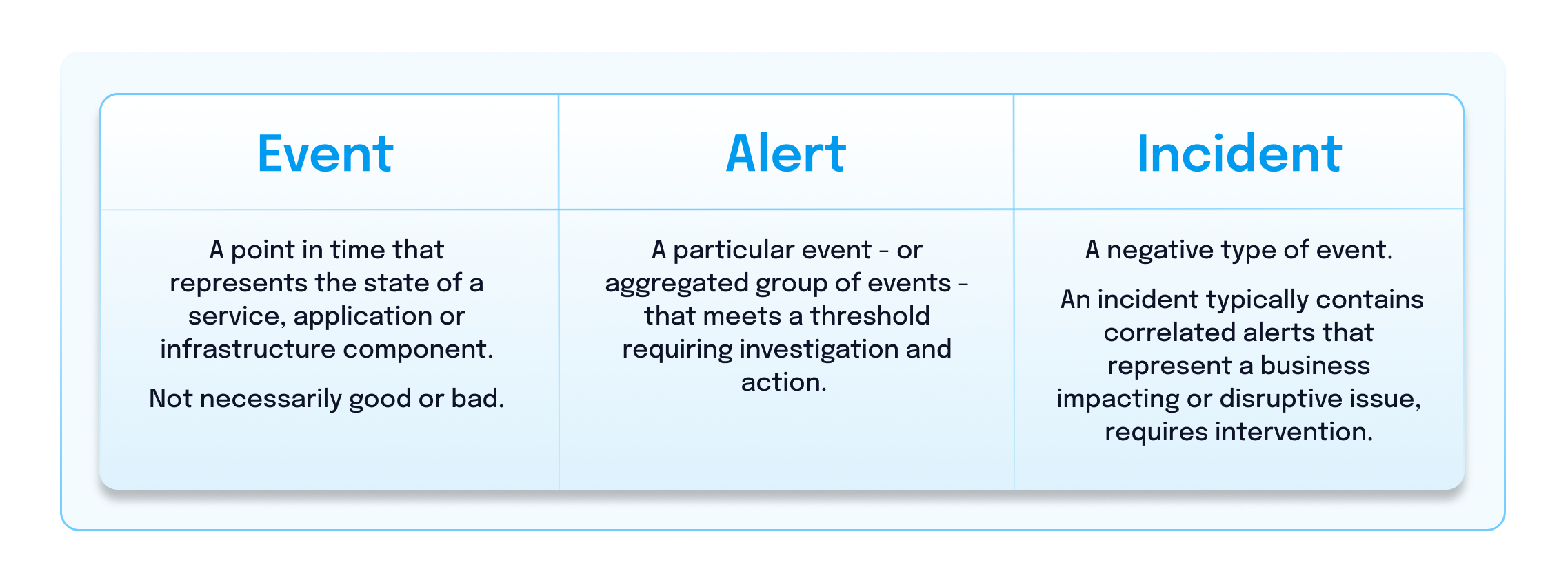What’s the difference between an event vs. alert vs. incident?

Are you confused by the difference between events, alerts and incidents in IT operations? It’s easy to get mixed up when you’re getting started in IT operations because of these concepts’ overlapping nature and interconnectivity.
However, it’s important to know the differences so you can accurately categorize and respond to various IT issues and ensure resources are allocated effectively.
Events, alerts and incidents are all integral parts of the IT monitoring and response framework but represent different stages or aspects of the process. Below, we’ll discuss the differences between these key concepts. Read on to better understand these essential ITOps concepts.
Monitoring in IT operations
IT operations monitoring is a part of managing modern digital infrastructures, where continuous surveillance of IT systems ensures optimal functionality. It involves tracking various metrics and logs to detect any changes or anomalies that could signify potential issues.
Monitoring forms the foundation for distinguishing between events (any observable occurrence in the system), alerts (a specific event that deviates from the normal or expected state) and incidents (specific events that disrupt normal service operations), each playing a unique role in IT ecosystem management. Let’s explore these in more detail below.
What’s an event vs. incident vs. alert?
- Event: In the context of ITOps, an event refers to any observable change or occurrence within a system, which could be routine, informational, or indicative of issues. All technology devices create events in the form of log entries and regular status updates, which are recorded as event data in various databases and other files.
- Alert: alert is a notification triggered by an event designed to inform stakeholders of a situation that needs attention.
- Incident: An incident is a specific kind of negative event that disrupts normal operations or services and requires intervention.

Understanding events, alerts, and incidents in real life
Consider a scenario where a server’s CPU usage spikes abnormally, this is an event detected by monitoring tools. If this spike leads to a service slowdown, it becomes an incident, prompting IT staff to investigate and resolve the issue.
In another example, a network security breach might trigger an alert, allowing IT teams to quickly respond before it escalates into a more severe incident. These scenarios exemplify how events, incidents, and alerts are identified and managed, showing the necessity of vigilance and accuracy in your IT operations monitoring.
Understanding analytics for events, alerts, and incidents
Analytics types play a vital role in proactive IT operations management. That’s why it’s crucial to understand how they can be used for events, alerts, and incidents to ensure that IT systems are reliable, secure, and aligned with business needs.
- Event analytics: Its goal is to identify patterns and anomalies within vast amount of event data. Correlation between seemingly unrelated event types across system, application, database, network, and security events help identify potential issues within event data.
- Alert analytics: Focuses on managing and analyzing alerts created by IT monitoring and observability tools. These alerts are typically triggered by predefined conditions such as performance thresholds, security breaches, or system failures. Alert analytics helps categorize, prioritize, and investigate these alerts to determine their significance and urgency.
- Incident analytics: Deals with examining and interpreting incidents within the IT infrastructure. An incident is an event that disrupts normal service operation and requires timely resolution. These analytics also play a crucial role in IT service management (ITSM) processes, aiding in continuous improvement and alignment with business objectives.
Best practices for managing events, incidents, and alerts
Effective management of events, incidents, and alerts in IT operations hinges on accurate identification and prompt response. For events, this involves setting appropriate thresholds and monitoring parameters to detect anomalies early. Incidents require a structured response protocol to minimize impact, including proper categorization, prioritization, and resolution strategies.
It’s crucial to ensure alerts are actionable, relevant, and not overwhelming, to avoid alert fatigue. Together, these practices ensure a robust and responsive IT operations environment.
Simplify event, alert, and incident management with BigPanda
BigPanda helps companies manage their events, incidents, and alerts by using Artificial Intelligence and machine learning to automate and streamline the process.
Efficiently aggregate and correlate data from multiple monitoring tools with BigPanda, to reduce noise and gain clear insights into critical issues. Experience what we can do in our demo, and see how to achieve quicker identification and resolution of incidents for improved operational efficiency and reduced downtime.



